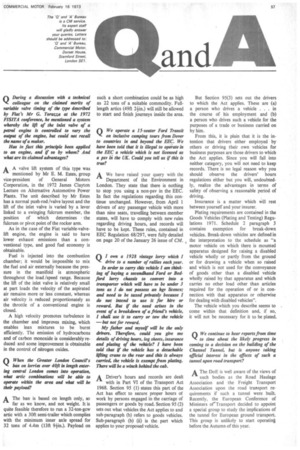Q I own a 1928 vintage lorry which I drive to
Page 59

If you've noticed an error in this article please click here to report it so we can fix it.
a number of rallies each year. In order to carry tins vehicle I am thinking of buying a secondhand Ford or Bedford lorry chassis to convert into a transporter which will have to be under 3 tons as I do not possess an hgv licence; and need to be taxed privately because I do not intend to use it for hire or reward. But if the need arises in the event of a breakdown of a friend's vehicle, I shall use it to carry or tow the vehicle — but not for reward.
My father and myself will be the only drivers. Therefore, could you give me details of driving hours, log sheets, insurance and plating of the vehicle? I have been told that if the vehicle has a detachable lifting crane to the rear and this is always carried, the vehicle is exempt from plating. There will be a winch behind the cab.
A Driver's hours and records are dealt
with in Part VI of the Transport Act 1968. Section 95 (1) states this part of the Act has effect to secure proper hours of work by persons engaged in the carriage of passengers or goods by road. Section 95 (2) sets out what vehicles the Act applies to and sub-paragraph (b) refers to goods vehicles. Sub-paragraph (b) (ii) is the. part which applies to your proposed vehicle. But Section 95(3) sets out the drivers to which the Act applies. These are (a) a person who drives a vehicle „ . in the course of his employment and (b) a person who drives such a vehicle for the purposes of a trade or business carried on by him.
From this, it is plain that it is the intention that drivers either employed by others or driving their own vehicles for business purposes are those drivers to which the Act applies. Since you will fall into neither category, you will not need to keep records. There is no legal reason why you should observe the drivers' hours regulations either but you will, undoubtedly, realize the advantages in terms of safety of observing a reasonable period of driving.
Insurance is a matter which will rest between yourself and your insurer.
Plating requirements are contained in the Goods Vehicles (Plating and Testing) Regulations 1971. Schedule 2 paragraph 3 contains exemption for break-down vehicles. Break-down vehicles are defined in the interpretation to the schedule as "a motor vehicle on which there is mounted apparatus designed for raising a disabled vehicle wholly or partly from the ground or for drawing a vehicle when so raised and which is not used for the conveyance of goods other than a disabled vehicle wholly raised by that apparatus and which carries no other load other than articles required for the operation of or in connection with that apparatus or otherwise for dealing with disabled vehicles".
The vehicle which you describe seems to come within that definition and, if so, it will not be necessary for it to be plated.












































































































